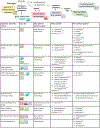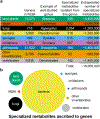Mining genomes to illuminate the specialized chemistry of life
- PMID: 34083778
- PMCID: PMC8364890
- DOI: 10.1038/s41576-021-00363-7
Mining genomes to illuminate the specialized chemistry of life
Abstract
All organisms produce specialized organic molecules, ranging from small volatile chemicals to large gene-encoded peptides, that have evolved to provide them with diverse cellular and ecological functions. As natural products, they are broadly applied in medicine, agriculture and nutrition. The rapid accumulation of genomic information has revealed that the metabolic capacity of virtually all organisms is vastly underappreciated. Pioneered mainly in bacteria and fungi, genome mining technologies are accelerating metabolite discovery. Recent efforts are now being expanded to all life forms, including protists, plants and animals, and new integrative omics technologies are enabling the increasingly effective mining of this molecular diversity.
© 2021. Springer Nature Limited.
Figures






References
-
- Davies J Specialized microbial metabolites: functions and origins. J. Antibiot 66, 361–364 (2013). - PubMed
-
- Chevrette MG et al.Evolutionary dynamics of natural product biosynthesis in bacteria. Nat. Prod. Rep 37, 566–599 (2020). - PubMed
-
- Ziemert N, Alanjary M & Weber T The evolution of genome mining in microbes - a review. Nat. Prod. Rep 33, 988–1005 (2016). - PubMed
Publication types
MeSH terms
Substances
Grants and funding
LinkOut - more resources
Full Text Sources
Other Literature Sources
Medical
Research Materials

